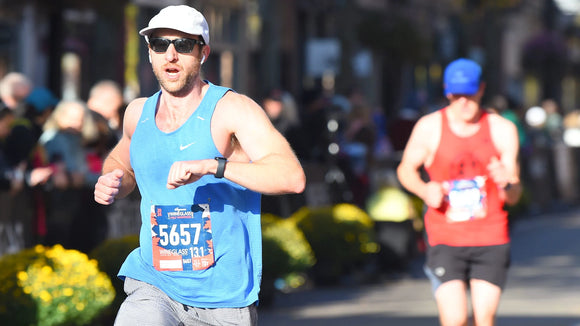Whether racing in ultra-marathons or running in sprints, hydration is key to a runner’s performance. Even a small decrease in hydration status can hinder physical function and performance while running. [1] Additionally, it’s tough for runners to accurately estimate how much sweat they lose as they run, resulting in unintentional dehydration. [2]
What does this mean for runners? Essentially, it means that having a hydration plan is important if you want to perform and feel your best while you train. Hydrating before and throughout your workout will help boost your performance, but drinking too much can cause that unpleasant “sloshing” feeling and sit in your stomach. For optimal hydration that doesn’t weigh you down, consider drinking 16 to 20 oz. of Osmo Active Hydration at least 30 minutes before your workout. Its optimized osmolality (or the ratio it contains of “stuff” to water) will absorb quickly from your gut and help keep your energy up. During your run, drink small sips every 10 minutes or so; if it’s a hot day, consider drinking more frequently.
For particularly intense efforts or a run in especially hot weather, drinking PreLoad the night before can help hyper-hydrate you so your body is primed for peak performance. If you are going to be running in the heat, you can even make a slushy with your PreLoad or Active to drink before you run; a 2010 study found that runners who drank an ice slushy were able to run up to 19% longer than when only drinking cold water. [3]
Though many runners like gels and chews for the convenience they offer, you need enough sodium to prevent hyponatremia, a condition that occurs when the level of sodium in your blood is too low. The sodium that Active Hydration contains can help prevent hyponatremia and maintain fluid balance, keeping you hydrated with the right balance of electrolytes and water. Additionally, the magnesium and potassium in Active Hydration can help prevent painful cramping.
After your run, it’s important that you get the nutrients you need to help repair your muscles and recover fully. The 30 minutes after your workout are the “Golden Window” of recovery, and getting the right nutrients during this time will help you grow stronger and more efficient while accelerating glycogen restoration. The three most important things to accomplish during recovery are 1) stopping the body’s exercise-induced catabolic (breakdown) response; 2) taking in high-quality protein to facilitate muscle repair; and 3) restoring the body’s glycogen stores. Our Recovery mix is made of a 2:1 protein to carbohydrates ratio with 30mg of caffeine. The protein shuts down the breakdown from exercise and enables muscle repair, while the carbs provide glycogen, helping you to recover quickly and feel great on your next run.
Running demands speed, endurance, and power, and hydrating correctly can enable you to perform at your best while feeling great. Finding a hydration and recovery routine that works for you (and sticking to it) can help bring your performance to new highs.
[1] Douglas J. Casa, Rebecca L. Stearns, Rebecca M. Lopez, Matthew S. Ganio, Brendon P. McDermott, Susan Walker Yeargin, Linda M. Yamamoto, Stephanie M. Mazerolle, Melissa W. Roti, Lawrence E. Armstrong, and Carl M. Maresh (2010) Influence of Hydration on Physiological Function and Performance During Trail Running in the Heat. Journal of Athletic Training: Mar/Apr 2010, Vol. 45, No. 2, pp. 147-156.
[2] Passe, D., Horn, M., Stofan, J., Horswill, C., & Murray, R. (2007). Voluntary Dehydration in Runners Despite Favorable Conditions for Fluid Intake. International Journal of Sport Nutrition and Exercise Metabolism, 17(3), 284-295.
[3] Siegel, R., Maté, J., Brearley, M. B., Watson, G., Watson, K., & Larsen, P. B. (2010). Ice Slurry Ingestion Increases Core Temperature Capacity and Running Time in the Heat. Medicine & Science in Sports & Exercise, 42(4), 717-725.



